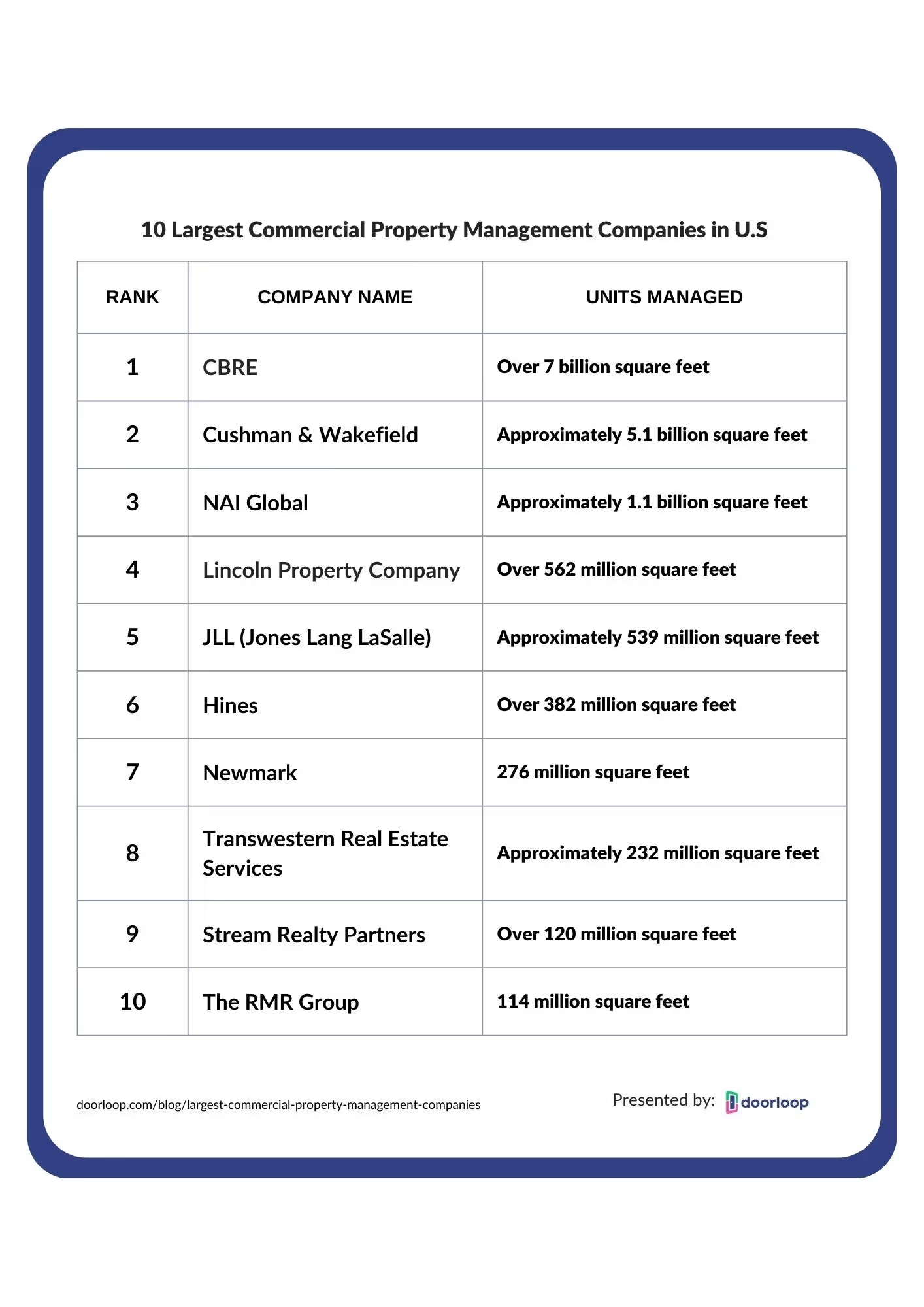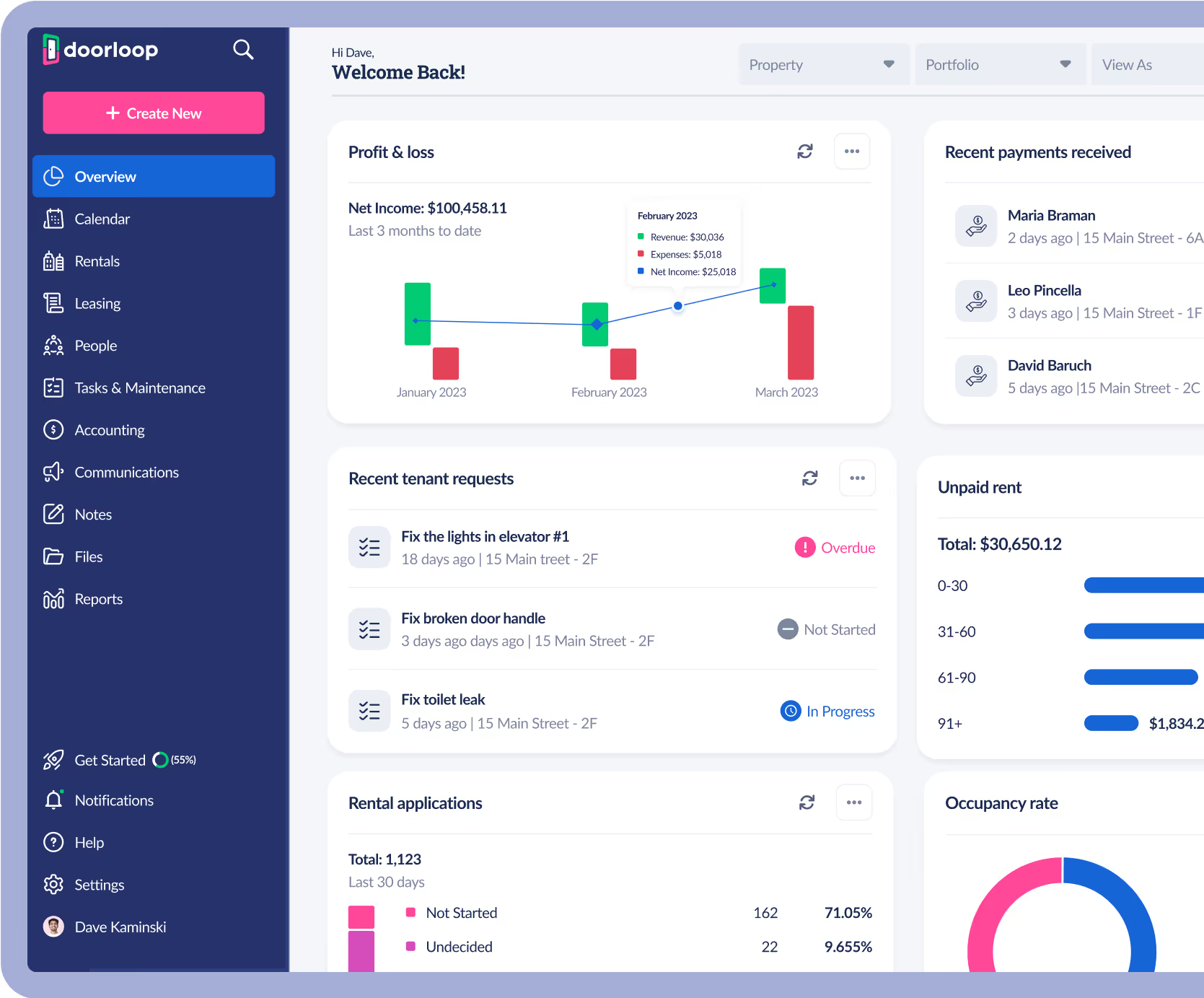Ever wonder who manages your favorite shopping mall or the sleek office building downtown? Behind the scenes, commercial property management companies play a crucial role in keeping these spaces occupied and running smoothly.
If you’re a commercial property owner or investor, you might be asking yourself: Should I hire one of these firms to manage my commercial portfolio?
With a multitude of companies offering a wide array of services, the decision to hire a property management firm should not be taken lightly.
Let’s take a look at commercial property landscape and the industry’s biggest players.
10 Largest Commercial Property Management Companies in U.S.
The following rankings are based on key metrics such as total square footage managed, revenue figures, and industry prominence, drawing from a combination of self-reported data, industry reports, and market research. These companies represent the best in class for managing diverse portfolios, including office buildings, retail spaces, and industrial properties.
Here are the top commercial property management firms, ranked by total square footage managed.
1. CBRE
- Portfolio Size: Over 7 billion square feet
- Headquarters: Dallas, Texas
- Revenue: $31.949 billion (2023 Annual Report)
CBRE is a global leader in commercial real estate services, managing over 7 billion square feet of commercial space worldwide. The company offers a comprehensive suite of services, including leasing, property sales, project management, and facilities management. Operating in over 100 countries, CBRE ensures consistent and innovative service delivery across diverse markets.
2. Cushman & Wakefield
- Portfolio Size: Approximately 5.1 billion square feet
- Headquarters: Chicago, Illinois
- Revenue: $9.5 billion (2023 Annual Report)
Cushman & Wakefield manages approximately 5.1 billion square feet of commercial property globally. The company focuses on delivering innovative solutions in property and facilities management. With a strong emphasis on sustainability and operational efficiency, Cushman & Wakefield remains a key player in shaping the real estate industry.
💡 Managing large-scale portfolios efficiently requires the right tools. Discover how DoorLoop’s commercial property management software can streamline operations, regardless of portfolio size.
3. NAI Global
- Portfolio Size: Approximately 1.1 billion square feet
- Headquarters: New York, New York
- Revenue: Estimated to be over $1 billion
NAI Global manages over 1.1 billion square feet of property and facilities worldwide. The company offers services across various commercial real estate sectors, including office, industrial, and retail properties. With a focus on providing tailored solutions, NAI Global continues to expand its footprint both in the U.S. and internationally.
4. Lincoln Property Company
- Portfolio Size: Over 562 million square feet
- Headquarters: Dallas, Texas
- Revenue: Approximately $1.4 billion (2022)
Lincoln Property Company manages approximately 562 million square feet of leased and managed properties, including joint ventures and third-party portfolios. The company specializes in real estate development, investment, and property management, offering solutions that cater to both residential and commercial markets.
5. JLL (Jones Lang LaSalle)
- Portfolio Size: Approximately 539 million square feet
- Headquarters: Chicago, Illinois
- Revenue: $20.8 billion (2023 Annual Report)
JLL is a global real estate services firm managing over 539 million square feet of commercial property. The company's expertise spans leasing, property management, and financial services, making it a key player in the commercial property management space.
6. Hines
- Portfolio Size: Over 382 million square feet
- Headquarters: Houston, Texas
- Revenue: Approximately $5.1 billion (as of November 2024)
Hines manages over 1,077 properties, covering 382 million square feet. The company is recognized for its innovative approach to property management, focusing on sustainability and long-term value creation. Hines operates across a diverse range of property types, including office, industrial, and retail.
7. Newmark
- Portfolio Size: 276 million square feet
- Headquarters: New York, New York
- Revenue: Approximately $2.6 billion (as of September 30, 2024)
Newmark manages approximately 276 million square feet of commercial property, offering services that include property management, leasing, and investment sales. The company emphasizes the use of technology to enhance operational efficiency and deliver superior value to its clients.
8. Transwestern Real Estate Services
- Portfolio Size: Approximately 232 million square feet
- Headquarters: Houston, Texas
- Revenue: Estimated to be approximately $623.9 million annually
Transwestern Real Estate Services manages approximately 232 million square feet of commercial property. The company provides a comprehensive range of real estate services, including leasing, property management, and advisory services, catering to a diverse client base.
9. Stream Realty Partners
- Portfolio Size: Over 120 million square feet
- Headquarters: Dallas, Texas
- Revenue: Estimated at approximately $272.6 million annually
Stream Realty Partners manages $4.7 billion in deal volume and over 120 million square feet of commercial properties. The company focuses on leasing, property management, and investment services, with an emphasis on creating value for its clients.
10. The RMR Group
- Portfolio Size: 114 million square feet
- Headquarters: Newton, Massachusetts
- Revenue: $897.6 million (Fiscal Year 2024)
The RMR Group manages approximately 114 million square feet of commercial property. The company specializes in property management, real estate services, and asset management, delivering comprehensive solutions to its clients.
These companies are at the forefront of commercial property management, providing innovative solutions to meet the evolving needs of property owners and tenants. With their extensive portfolios and strong financial performance, they continue to set benchmarks in the industry.

Curious about the overall largest property management companies in the U.S.?
Commercial Real Estate Market Projection (2025-2029)
According to Statista, the commercial real estate market presents significant growth potential:
- Worldwide market value by 2025: $120.00 trillion
- Annual growth rate (2025-2029): 1.35%
- Projected market volume by 2029: $126.60 trillion
The United States is set to lead the real estate sector, with an estimated market value of $25.8 billion in 2025.
Did You Know?
In the United States, the commercial sector accounts for about 39.8% of LEED-certified projects, closely following the residential sector, which holds 42.9%.
Key Growth Drivers of Commercial Real Estate
The commercial real estate (CRE) market is undergoing dynamic growth and transformation, driven by a confluence of local, national, and global factors. Understanding these drivers is essential for property owners to identify opportunities, mitigate risks, and maximize the value of their investments. Below, we explore the most influential factors shaping the CRE landscape.
Evolving Preferences for Flexibility and Sustainability
- Flexibility: Businesses are increasingly prioritizing adaptable spaces to meet evolving workforce needs, such as hybrid workplace models. This has driven demand for flexible lease terms and multi-purpose layouts.
- Sustainability: Green buildings with energy-efficient systems and certifications like LEED or WELL are not only attracting eco-conscious tenants but also commanding higher rents and reducing operating costs.
Rising Popularity of Co-Working Spaces and Mixed-Use Developments
- Co-Working Spaces: Co-working environments have expanded beyond startups to include large enterprises seeking cost-effective, collaborative spaces. This trend is reshaping office space requirements.
- Mixed-Use Developments: Developments combining residential, commercial, and retail spaces cater to modern preferences for convenience and community while offering diverse revenue streams for property owners.
Impact of Local Dynamics
- Urbanization: Rapid urbanization in key regions has spurred demand for commercial spaces, including offices, retail locations, and logistics facilities.
- Supportive Government Policies: Tax incentives, subsidies for green buildings, and infrastructure investments are driving CRE development, especially in growth markets.
Broader Macroeconomic Drivers
- Economic Growth: A strong economy fuels business expansion and consumer spending, directly increasing demand for commercial properties.
- E-Commerce and Globalization: The rise of e-commerce has heightened demand for logistics facilities, while globalization continues to create opportunities in warehousing and retail sectors.
Technological Advancements
- Smart building technologies like IoT enable property owners to optimize energy use, enhance security, and improve tenant experiences.
- Proptech innovations simplify processes such as tenant communication, lease management, and reporting, making property management more efficient and attractive.
Resilience of Certain Asset Classes
- Industrial Properties: High demand for warehouses and distribution centers persists due to e-commerce and just-in-time inventory models.
- Life Sciences and Healthcare Facilities: The pandemic has underscored the need for specialized facilities like labs and medical offices.
- Multifamily in Mixed-Use Developments: These remain stable investments, as demand for housing near commercial amenities continues to grow.
Do You Need a Commercial Property Management Company?
The evolving commercial real estate market presents both opportunities and challenges for property owners. Trends like sustainability, flexible spaces, and co-working models are reshaping the industry, making property management more complex than ever.
For many property owners, this raises an important question: Should you manage your portfolio yourself, or outsource to a professional property management firm?
Outsourcing offers expertise and convenience, particularly for large-scale portfolios requiring significant resources and specialized knowledge. However, it typically comes with a cost of 8% to 12% of your rental income, which may not suit every investor.
For property owners managing smaller or mid-sized portfolios, self-management software like DoorLoop simplify operations and reduce costs. To explore other top-rated tools that can help manage your properties efficiently, check out this list of the 10 best commercial property management software options. Whether through automation or streamlined workflows, self-management software like DoorLoop offers practical ways to streamline operations and maintain control.
Ultimately, the right approach depends on your unique goals, the complexity of your portfolio, and your resources. For extensive, high-value portfolios requiring specialized knowledge or significant on-the-ground presence, outsourcing might be the best fit. However, for those looking to save on management fees, retain control, and streamline operations, self-management software can be an effective alternative.
By weighing the benefits of outsourcing against the flexibility of managing commercial properties yourself, you can make a decision that aligns with your long-term objectives.






























.svg)
.svg)

